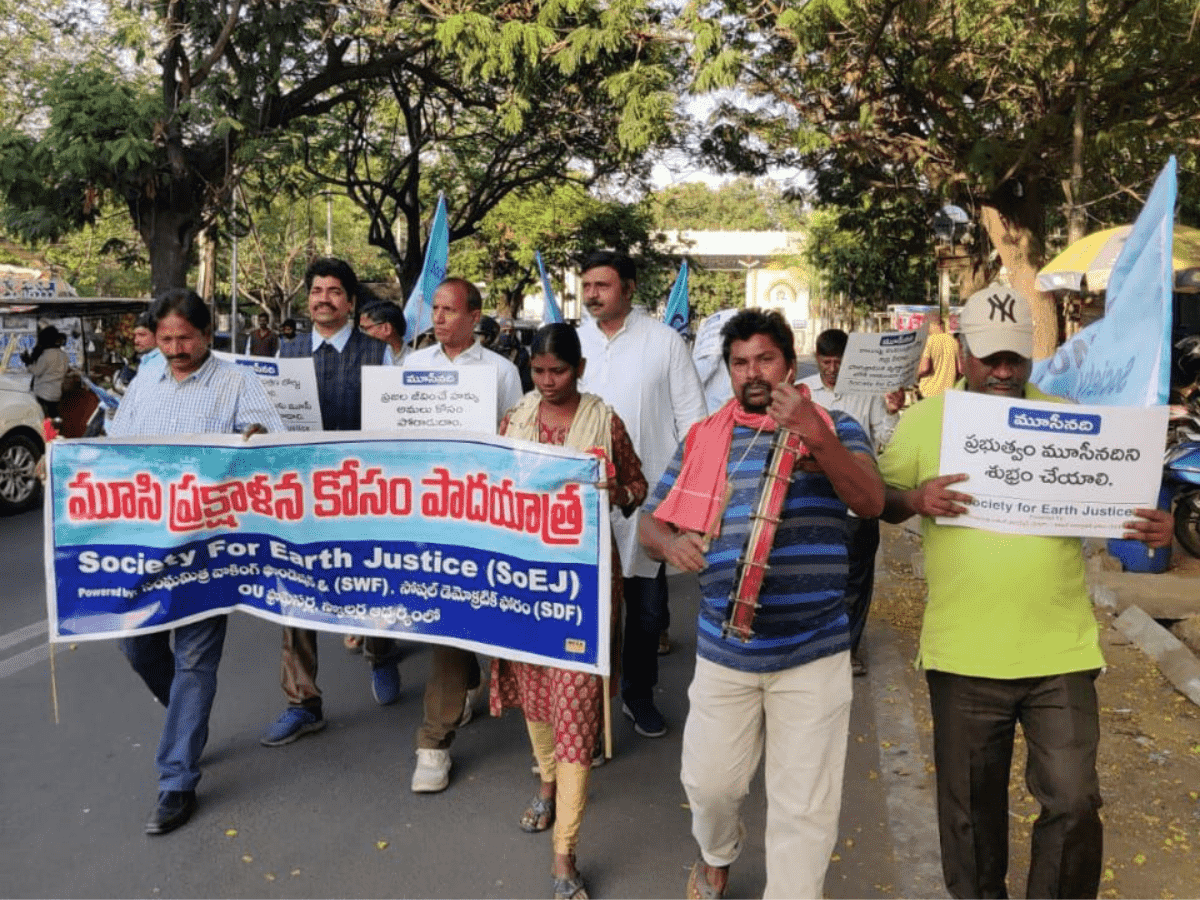
Hyderabad: Society for Earth Justice, a charitable organisation carry out a 49-day padayatra, in different parts of the city to encourage the rejuvenation of the river Musi.
Musi, a tributary of Krishna River that flows in Hyderabad and surrounding areas is polluted by sewage and industrial waste containing toxic and hazardous materials such as heavy metals, phenols, and pesticides.
This pollution is affecting crops, livestock, and dairy products, as well as causing skin problems, eye problems, and vomiting in certain seasons.
The research work cited in this content highlights the severity of the issue, and its impact on the environment and public health, hence making it crucial to take action to prevent further pollution and protect the river and its surrounding areas.
Member of the Society for Earth Justice organisation, Acharya Venkatadas, while speaking to the media said that the grass and vegetables grown in the muddy waters of river Musi has become poisonous and milk obtained from the grass-fed cattle is not fit to be consumed by human beings.
The first phase of padayatra took place between March 29 to April 6.
The organisation kickstarted its foot march on April 23 from Osmania University Engineering College to RTC X Road.
The padayatra will be taken up from 4 pm to 8 pm every day where a clean-up drive on the river banks will also be executed. They requested the cops to make necessary arrangements for the success of the noble cause.
Why is the Musi River water polluted?
The river, which was once a source of life, has now become closed and has detrimental effects on the people living in the area.
The river originates from the Anantagiri Hills in Vikarabad, Telangana, and flows through several places in Hyderabad, including the High Court, City College, Osmania General Hospital, Salar Jung Museum, and State Central Library.
In the early 20th century (1900-1950), the river faced significant flooding, and the carcasses of dead animals made it unsuitable for any use.
Despite being about 6.5 meters deep and having a basin width of 240 km, the Musi River has become useless due to urbanization and a lack of planning.
The pollution comes from various sources, including sewage and industrial waste, and affects the water, air, soil, and livestock.
The primary reason for the river’s pollution is the dumping of untreated domestic waste, including municipal drainage water, which is discharged into the river.
Approximately 350 million litres of sewage waste are discharged into the Musi River every day, and sewage from about 54 measured canals is also dumped into the river.
In fact, about 94 percent of sewage from the Hyderabad and Secunderabad cities flows into the closed river.
Tap water, which is essential for drinking, has become highly polluted due to this problem
It is high time to take corrective measures to restore the river’s purity and it is a source
of life for the people living in the area.
The Musi River gets polluted by 54 drains from Hyderabad and Secunderabad, which carry sewage and domestic waste.
These wastes contain harmful chemicals, including toxic and hazardous materials. Moreover, industrial wastewater from areas like IDA Uppal, Patancheruvu, and Jeedimetla is also dumped into the Musi River, which contains very toxic and hazardous wastes like heavy metals, phenols, soaps, pesticides, and fungicides.
Are there heavy metals present in crops like wheat, rice, and vegetables? Yes, there are reports indicating that industrial effluents containing cadmium, zinc, and chromium are present in micro quantities in these crops.
However, the concentrations are variable and seasonal, and there is no exact data available. What are the milk-related issues associated with the Musi River?
The downstream of the Musi River covers almost 20 to 30 villages from Pratapsingaram to feed. Some reports suggest that cow milk contains small concentrations of DDT and other fungicides due to pollution in villages like Enkiryal, Surapalli, and Aroor.
What is the impact of the Musi River on air pollution?
While the Musi River problem is mainly related to water pollution, the vapours and odours from downstream give off a specific smell, which is unpleasant and harmful.
The copper works and coatings in automobiles are getting destroyed, and the bronze and copper materials of door bolts, nuts, and lockers are changing colour.
Does the use of Musi River water in agriculture reduce soil productivity?
There is a definite reduction in crop, fruit, and flower yields, as well as a decrease in poultry and livestock. Several reports have been attached to support this claim.
What diseases are associated with the Musi River water?
The Musi River water has been linked to several health issues, including skin problems, eyesight-related issues, and vomiting during monsoon season.
What other disturbances are caused by a polluted Musi?
Pollutants such as metals, organics, and toxic substances are deposited at the bottom level of the river, percolate and penetrate into the surface, ground, and underground water, and threaten the handloom and cottage industries on the river banks.
The dairy industry is also impacted by cow milk contamination, which leads to changes in the quality, colour, and taste of curd and butter.
What pollutants are present in the Musi River?
The Musi River contains various pollutants, including turbidity, total dissolved solids, pH, electrical conductivity, hardness, biochemical oxygen demand, chemical oxygen demand, nitrates, nitrites, carbonates, bicarbonates, sulphates, chlorides, potassium, calcium, magnesium, and sodium. Sources of research work include the Indian Journal of Applied Engineering Research, the International Journal of Engineering Science and Computing, the IOSR Journal of Environmental Science, Toxicology, and Food Technology, and WHO publications.



